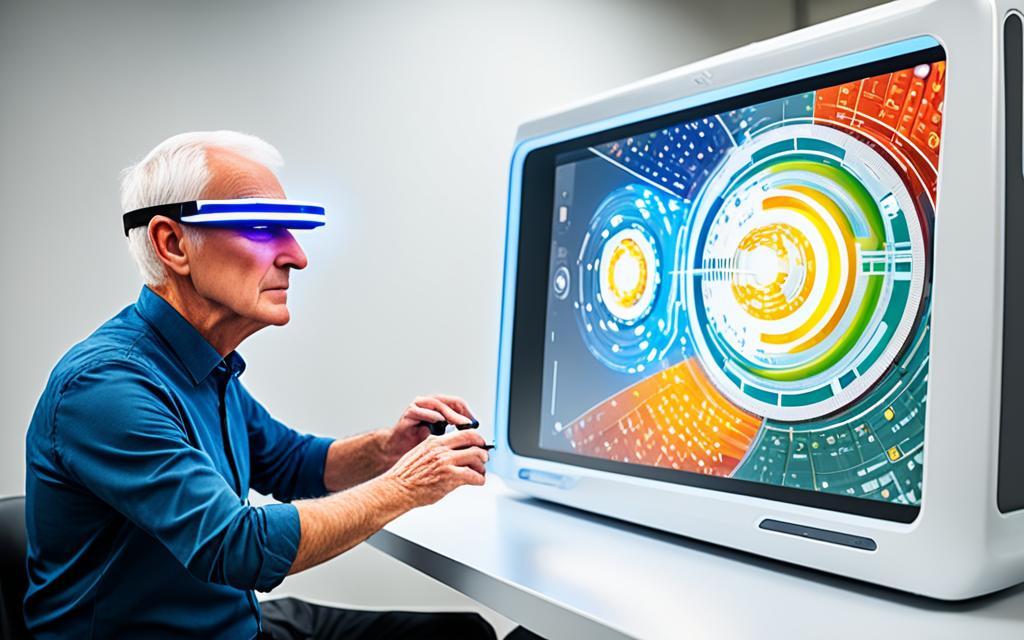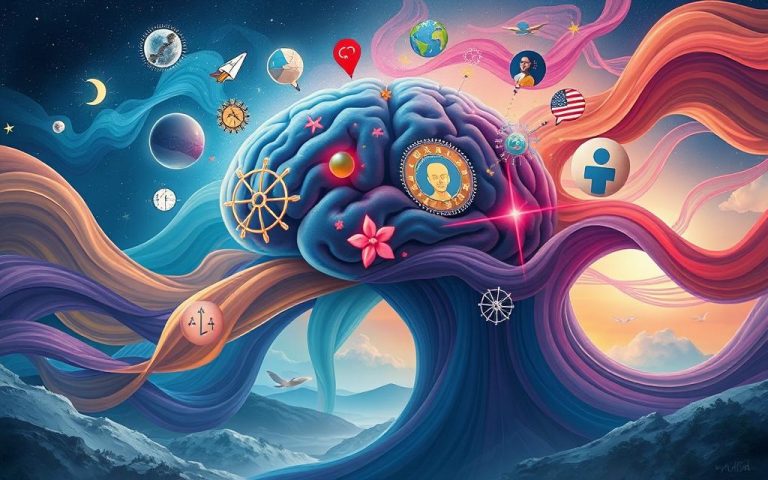Effective Vision Therapy Treatment Options
Exploring vision therapy treatments can make your life better by improving your visual skills. If you want to help your eyes and see better, learning about these treatments is a smart first step. Vision therapy is tailored to each person, including exercises and strategies to help eye coordination and focus.
This approach is personalized to make your eyes stronger. The aim is to help your eyes work at their best and give you clearer vision.
Key Takeaways
- Vision therapy can greatly boost visual skills, leading to healthier eyes and better sight.
- Effective vision therapy has customized treatment plans that match the specific needs of patients.
- Through special exercises, patients can improve their eye coordination and focusing.
- There are many treatment options, offering a fit for every patient’s needs.
- Starting to learn about vision therapy could be your first step to clearer vision.
Understanding Vision Therapy Treatment
Vision therapy is supported by healthcare experts, including the American Optometric Association and the College of Optometrists in Vision Development. It is significant in improving visual skills. Vision therapy is about enhancing visual health through specific methods.
What Is Vision Therapy?
Vision therapy involves special activities and exercises that fix certain vision problems and improve visual skills. It does more than just compensate for vision issues like eyeglasses and contact lenses do. Instead of changing the eye’s structure through surgery, it works on the brain’s vision pathways. This vision rehabilitation approach is key to better visual performance and processing.
How Does Vision Therapy Work?
Patients work with trained vision therapists in clinics. Each session is made just for them, using exercises that meet their specific needs. Techniques such as therapeutic lenses, prism lenses, filters, and computer programs help improve eye alignment, tracking, and focusing. This makes vision training more effective.
Vision therapy programs aim to build a strong visual system. This system understands and reacts to what we see. It’s crucial for reading, writing, and tasks needing good vision.
With regular targeted exercises, patients see big improvements in how they see. This can greatly enhance how they live. The American Optometric Association and the College of Optometrists in Vision Development back these exercises. They say these methods really work to better vision.
Who Can Benefit from Vision Therapy?
Vision therapy helps many people. It suits various ages and needs. You’ll see if it’s right for you or your loved ones by understanding its workings and benefits.
Vision Therapy for Children
Vision therapy is great for kids. It tackles issues that might hinder their learning and growth. Problems like strabismus (crossed eyes) and amblyopia (lazy eye) can get better or even go away with tailored vision therapy plans.
This therapy also boosts vital visual skills. Skills like hand-eye coordination and visual processing speed are key for doing well in school. Since kids’ vision systems are still developing, starting vision therapy early often leads to better results. This helps them excel in school and have fun in their hobbies.
Vision Therapy for Adults
Adults benefit from vision therapy too. It aids adults facing issues due to the digital nature of today’s workplaces. The therapy might enhance visual sharpness and how quickly they process what they see. This makes them more productive and efficient at work.
Plus, it’s great for adults into sports or those tackling demanding visual tasks again. It hones visual skills like depth perception and dynamic visual acuity. This boosts their performance and gives them an edge in competition.
Vision therapy impacts life and abilities at any age. It helps solve vision issues or better visual skills. Looking into vision therapy might change your visual health and how well you see.
The Goals of Vision Therapy Programs
Vision therapy programs are tailored to meet individual needs. They improve visual abilities by focusing on each person’s specific requirements. This customization makes the therapy highly effective for every participant.
Visual performance improvement is a key goal of vision therapy. Through exercises and therapeutic devices, patients enhance crucial skills. Skills like binocular vision and depth perception are developed. This reduces visual stress and improves daily life activities.
- Enhancing depth perception to aid in more effective spatial navigation.
- Reducing visual stress for longer, more effective reading and screen time.
- Improving binocular vision to support better coordination and balance.
Personalized vision therapy helps those with visual discomfort or learning disabilities. The specific exercises can lead to better educational results. For working adults, it boosts productivity and lessens eye strain, aiding in professional success and overall well-being.
The goals of personalized vision therapy are comprehensive. They aim for immediate and sustainable visual health improvements. These programs provide lasting benefits, whether for education, work, or quality of life, building a strong visual foundation for all.
Initial Assessment: Starting Your Vision Therapy Journey
Starting a vision therapy program begins with a key first step – a detailed eye check-up. This exam is performed by a skilled developmental optometrist. It sets the stage for customized visual training to fix specific vision problems. We’ll explain the process and how a treatment plan is made, using real case studies as examples.
Comprehensive Eye Examination
Your vision therapy starts with an in-depth eye exam. It’s not only about seeing clearly from a distance. It also looks at how well your eyes work together, focus, and process information. Finding out the exact issues with your vision is important. It helps create a set of exercises specifically for you.
Developing a Customized Treatment Plan
After your eye exam, the next step is making a personalized treatment plan. This plan uses information from your first visit. It focuses on improving how your eyes move, understand visuals, and work together. This ensures every therapy session helps make your vision better.
| Assessment Area | Common Issues Identified | Vision Therapy Exercises Applicable |
|---|---|---|
| Eye Coordination | Poor teaming ability | Eye teaming exercises to improve coordination |
| Focusing Abilities | Difficulty maintaining clear vision at different distances | Accommodative exercises to enhance focusing precision |
| Visual Processing | Problems with visual memory or discrimination | Visual perceptual therapy to strengthen interpretation skills |
Case studies and real examples help explain each part of the treatment plan. This gives you a better understanding of how vision therapy exercises are customized. It ensures the treatment works well for you.
Core Components of Vision Therapy Exercises
Vision therapy exercises boost eye health and visual skills. They include eye tracking, coordination tasks, and focus training. Each aims to improve how well our eyes work together.
Eye Tracking and Coordination Exercises
Eye tracking helps make eye movements smoother and more precise. By doing these exercises, you can better track moving objects or switch focus easily. This can improve how you read and play sports. Here are some eye tracking exercises:
- Brock String: This improves visual focus and perception by concentrating on beads at different distances on a string.
- Pencil Push-Ups: By moving a pencil towards and away from the nose, you boost control over eye muscles.
Focusing and Convergence Training
Focusing and convergence exercises strengthen how well eyes adjust to different distances. These are great for those who get eye strain from lots of close work. Here are some important activities:
- Near-Far Focus Shift: This boosts your ability to quickly change focus between objects near and far.
- Convergence Exercise: This helps improve the eyes’ ability to focus together on a close object, aiding in better reading.
Through regular practice of these exercises, you can enhance visual accuracy and ease eye strain. This leads to better vision and comfort.
The Role of Technology in Vision Therapy
Technology is changing the way we do vision therapy. Vision therapy technology is now a big part of treatment. It lets patients do tailored exercises at home or in clinics. This is thanks to computer-based vision therapy.
Tools for vision therapy now use virtual and augmented reality. They make therapy fun and track progress accurately. This helps doctors make the right adjustments.

- Software programs help with skills like focus and hand-eye coordination.
- Virtual reality helps patients improve how they process visuals.
- Online platforms let therapists update treatments with the latest data.
| Technology Type | Benefits | Use Cases |
|---|---|---|
| Software Applications | Flexibility, customization, remote access | Home-based therapies, daily exercises |
| Virtual Reality | High engagement, controlled environment | Clinical settings, advanced therapies |
| Real-time Monitoring Tools | Data-driven adjustments, enhanced tracking | Long-term therapy programs, multi-patient use |
With these vision therapy tools, treatment is better and more flexible. When thinking about your eye health, consider computer-based vision therapy. It could make your treatment easier and more successful.
At-Home Versus In-Office Vision Therapy Programs
Choosing between at-home and in-office vision therapy is important for your treatment’s success. Each option has different benefits fitting various needs and lifestyles. It helps to know these differences to choose the right one for you.
Pros and Cons of At-home Vision Therapy
- Convenience: You can perform exercises at your own pace and schedule, which makes at-home vision therapy particularly appealing for those with busy schedules.
- Cost-effectiveness: Generally, at-home programs can be less expensive than in-office sessions due to the reduced need for regular professional supervision.
- Requires discipline: The success of at-home vision therapy heavily relies on your commitment to consistently follow the prescribed exercises without professional supervision.
- Limited equipment: You might have access to fewer therapeutic tools and technologies compared to what is available in a clinical setting.
When to Consider In-office Vision Therapy
In-office vision therapy might be better if you prefer direct supervision or need special treatments. Some complex vision problems require the advanced equipment and expertise found in clinics.
| At-Home Vision Therapy | In-Office Vision Therapy | |
|---|---|---|
| Flexibility | High – exercises anytime | Low – scheduled sessions |
| Cost | Lower | Higher |
| Professional Supervision | Minimal | High |
| Equipment | Basic | Advanced |
| Suitable For | Minor issues, maintenance | Complex vision problems, intensive therapy |
Considering vision therapy options, at-home and in-office each have unique benefits. Assess your situation and talk with a vision care professional. This helps make a choice that meets your vision health goals.
Measuring the Success of Vision Therapy Treatment
Starting vision therapy comes with the need to grasp both its effectiveness and the ways we measure this success. It’s key to set realistic expectations early on and to monitor tracking vision therapy progress closely. This approach is vital for reaching significant achievements.
Setting Realistic Expectations
For vision therapy to work well, setting realistic goals is crucial. It’s about knowing what the therapy can achieve and its limits. While it can greatly improve your visual abilities and ease visual stress, it’s not a cure-all. The outcomes can differ, depending on how committed you are and your specific visual issues.
Tracking Progress Over Time
Measuring vision therapy’s success involves frequent check-ins with your eye doctor. These check-ups help keep track of your visual skills’ growth and tweak your treatment as needed. This careful monitoring keeps the therapy on track and ensures it meets your initial goals.
- Initial Assessment: Detailed testing before starting the therapy to establish a baseline.
- Ongoing Evaluations: Regular sessions to observe progress and make adjustments to the therapy.
- Final Assessment: A comprehensive evaluation to compare with the initial baseline and measure overall improvement.
Knowing how to measure tracking vision therapy progress and seeing real changes in visual tasks matter a lot. This knowledge helps both the specialist and the patient stay driven. It makes the therapy journey more rewarding for everyone involved.
Vision Training Tools and Equipment
Starting vision therapy means learning about vision training tools and vision therapy equipment. These tools help fix different vision problems. They make your therapy better and more effective.
There are many types of equipment used in vision therapy. Some are simple, while others are high-tech. Each one has a key role in improving your vision.
Let’s talk about the devices you’ll see most often. They play a big part in making vision therapy work.
- Therapeutic Lenses: These glasses are special. They change how light gets into your eye. This change is important for fixing certain eye problems.
- Prisms: Prisms are for changing how you see the world. They’re used if your visual field needs adjusting. This is really helpful for people with seeing things in the wrong place.
- Computerized Systems: These are fancy vision tools. They watch how your eyes move and give feedback right away. This helps make treatment better because it’s more personalized.
- Balance Boards: Balance boards work on connecting vision and body movement. They improve posture and help you understand where you are in space better.
These tools are chosen with care for each patient. The goal is to pick the right tool to make vision skills better. It shows how tailored vision therapy is for each person.
Learning about these tools can make a big difference in your therapy. With the right equipment, therapists can focus on what will help the most. This leads to big improvements in how well you see.
Specialized Vision Therapy for Specific Conditions
Dealing with specific visual impairments needs focused vision therapy. Conditions from injuries or birth require a targeted approach. This helps manage and possibly fix visual deficits.
Vision Rehabilitative Therapy After Injury
Recovering from a visual injury involves detailed rehab strategies. The aim is to get back vision functionality lost to trauma or brain events. These programs are made to help patients recover important visual skills.
Therapy for Strabismus and Amblyopia
Strabismus and amblyopia therapies are special types of vision therapy. They work on fixing eye misalignment and boosting vision clarity. Strabismus therapy uses exercises to better eye alignment and coordination.
Amblyopia therapy, or addressing lazy eye, includes activities that help the brain use the weaker eye more. These therapies improve visual perception and boost life quality by enhancing confidence and social skills. Their positive effects are proven by various studies.
In summary, specialized vision therapy is vital for recovery or developmental challenges. It offers a clear path to better vision and improved life quality for many.
How to Choose the Right Vision Therapy Program
When picking a vision therapy program, it’s key to find one that fits your needs well. Look into the program’s credentials and think about what the patient needs. A good choice can really help improve how well you see and your life quality.
Evaluating Program Credentials
Start by checking the program’s credentials carefully. Think about its accreditation, the team’s skills, and its success stories. Programs with accreditation meet set standards, which means they likely offer good care and use the best therapy practices.
Considering Patient Needs and Goals
Everyone’s needs and goals for vision therapy differ greatly. It’s important to choose a program that matches what the patient wants to achieve. This could be doing better in school, being more productive at work, or improving how well they handle daily tasks.
| Consideration | Details |
|---|---|
| Customized Treatment Plans | Programs should offer tailored strategies that address individual visual deficiencies and goals. |
| Technological Integration | Advanced technology can enhance treatment effectiveness and engagement, especially in children and young adults. |
| Follow-up Procedures | Effective programs include regular assessments to monitor progress and adjust treatments as necessary. |
To choose the best vision therapy program, really look into its credentials and match it with the patient’s needs. Doing this helps ensure the program will give the best results for better vision.
Integrating Vision Therapy with Other Treatments
Looking into treatments for vision problems, mixing vision therapy with other medical treatments can make a full care plan. This combo takes care of health from all sides. It uses a whole-health view which is key in team healthcare.
When Vision Therapy is Part of a Larger Treatment Plan
Vision therapy with a larger health plan means working with different medical experts. This mix not only fixes vision issues but also boosts brain health and function. It shows how flexible and full a care plan can be.
Adding vision therapy helps with problems that hit thinking skills, greatly lifting quality of life. Working with other fields makes sure the care covers all health aspects, tailoring it to the person.
Working With Other Healthcare Professionals
Doctors working together is key for a treatment plan that includes vision therapy. In this team approach, doctors share ideas, match goals, and create plans that fit the patient best.
Good talk and regular meet-ups between doctors help keep track of how the patient is doing. They adjust the care plan as needed. This way, all treatments, including vision therapy, work better, leading to quicker and lasting healing.
Insurance and Coverage Options for Vision Therapy
When you think about trying vision therapy, it’s smart to know what your insurance will help with. Understanding vision therapy insurance is key, even though it can seem hard at first. Most times, healthcare plans will help pay for parts of the therapy if it’s needed for medical reasons. Still, how much they help can change a lot depending on your insurance.
Finding out what your insurance does for coverage for vision therapy can be tricky. Each insurance plan is different. Some might help pay for the first check-up and later visits. Others might only help pay for certain exercises or tools. If your insurance doesn’t help much or at all, talk to your therapy provider about other ways to pay.
It’s also good to keep up with changes in healthcare plans for vision therapy. As more is learned about its benefits, some insurances are offering better coverage. Keep talking to your insurance company to stay up-to-date on any new options that could help you. Always check your plan’s details when it’s time to sign up for the year again. Insurance for vision therapy can seem confusing, but knowing more about your plan and what’s happening in healthcare will help you make the best choices for your eyes.
FAQ
What is vision therapy?
Vision therapy involves eye exercises prescribed by an optometrist. These exercises improve eye coordination and visual skills. It’s also known as vision training or rehabilitation. The goal is to enhance visual abilities for better eyesight and health.
How does vision therapy work?
It strengthens the visual system with progressive exercises. A trained optometrist oversees these programs. Tools are used to enhance eye tracking, focusing, and teaming abilities.
Who can benefit from vision therapy?
Vision therapy benefits children and adults with vision problems. Glasses or contacts alone might not correct these issues. It helps children with learning-related vision issues and adults needing better visual skills.
What are the goals of a vision therapy program?
Goals include improving binocular vision and depth perception. It also aims to refine visual performance and reduce stress. Goals are tailored to each person’s needs. This improves education, work, and quality of life.
What does a comprehensive eye examination entail before starting vision therapy?
Before therapy, a detailed eye exam is conducted. This includes checking visual acuity, eye teaming, and movements. A developmental optometrist creates a customized plan based on the results.
What are some common vision therapy exercises?
Common exercises include eye tracking and coordination activities. There’s also focusing exercises and convergence training. Tools like Brock strings or digital devices are used. These exercises strengthen eye muscles and control.
How has technology impacted vision therapy?
Technology introduced dynamic computer-based exercises and virtual reality. These tools provide immersive experiences that improve outcomes. Patient compliance benefits from these engaging practices.
Should I choose at-home or in-office vision therapy?
The choice depends on individual needs and severity of vision problems. Home therapy offers convenience. Office therapy provides structured treatments. Consider the therapy’s intensity too.
How do you measure the success of vision therapy treatment?
Success is measured by achieving set goals and improvements in visual abilities. Progress is tracked over time. Regular assessments ensure the therapy’s effectiveness.
What kinds of tools and equipment are used in vision therapy?
A range of tools are used, from simple lenses to sophisticated digital devices. These assist with exercises and measuring eye movements. They’re key to the practice.
What specialized vision therapy treatments are available for specific conditions?
Specialized treatments exist for strabismus, amblyopia, and post-injury vision issues. Tailored programs address these conditions effectively. They’re backed by scientific research.
How can I choose the right vision therapy program?
Look at the program’s credentials and the providers’ qualifications. Ensure it meets the patient’s vision needs and goals. Consider accreditation and success stories.
Can vision therapy be integrated with other treatments?
Yes, it can be part of a multidisciplinary approach. Integrating it with therapies like occupational therapy improves overall health. This approach often yields the best results.
What are the insurance and coverage options for vision therapy?
Coverage varies by insurance provider and plan. Some aspects of therapy may be covered. Knowing your policy and exploring funding options is important. Consult with your practitioner and insurance to understand your coverage.






